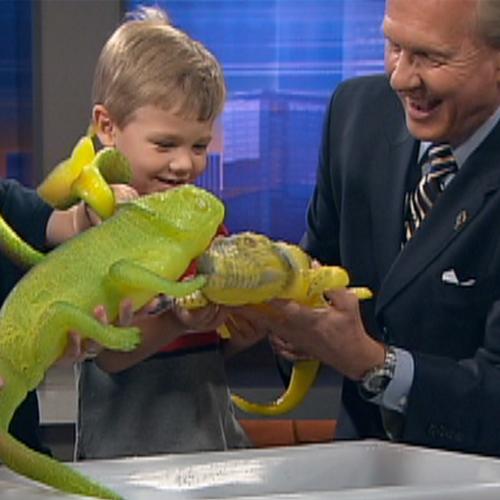The Baby Diaper Secret
If you’ve ever changed a diaper and noticed what looked like tiny crystals on the baby’s skin, you’ve uncovered the secret of superabsorbent, disposable diapers. […]

Have you ever wanted your own pet alligator, but just didn’t think it would work in the classroom or in your bedroom? Try this experiment and watch as these tiny creatures grow 5 to 10 times their original size… maybe more… once you drop them in water. These growing wonders are made out of a special superabsorbent polymer that soaks up water. The polymer, or hydrogel, is similar to the non-toxic chemical used in baby diapers. So, don’t overlook the educational value of these popular toys.
It’s important to gather data as you conduct the experiment in order to make some meaningful conclusions at the end of the experiment – besides growing an enormous creature. Start by examining the lizard (for example). One of the easiest ways to take measurements is to place the growing thing on a piece of graph paper and trace around it. Simply count the squares to determine the area and size of the object.
Fill the huge plastic tub or aquarium with room temperature water. Be careful not to use hot water because it will make the growing creature break up into tiny pieces. Some people have great results using distilled water. Most experimenters report that slightly warm water makes the creatures grow best and distilled water is a great choice if you have it. Place all of the growing creatures (if you have more than one) into the water.
It’s fun to watch the creatures grow for the first 24 hours… but don’t be disappointed if it’s not huge. It takes a full week for the creature to get really big. After 24 hours, remove the creature(s) from the water and carefully dry them off with a paper towel. Take measurements and record your data on your graph paper. GROWING TIP: Change the water each day for the first few days. We’re not sure if it’s the fresh water aspect or the fact that you’re adding more warm water that activates the polymer and helps it to absorb the water. Regardless, it works – so try it!
Back to the water they go for another 24 hours. Continue gathering data until the creatures stop growing. How do you know when they’re done growing? That’s the $64,000 question. We’ve seen the growing lizard grow to 36″ long, but it really all depends on the water quality and keeping the water at room temperature. Regardless, the Giant Growing Creatures should grow to at least 3 times their original size and reach their maximum size after 7 days.
If the tub or aquarium is sitting on your desk, be prepared to have to answer lots of questions. Tell people not to touch your creature because it might bite. Oh, be sure to name the creature… because you can’t just call her “creature.”
These super-slurping, water-absorbing creatures are made out of a special chemical called a superabsorbent polymer, or hydrogel. Think of this polymer as millions of microscopic sponges that absorb water. These growing creatures are made out of two different polymers: a hydrophilic (water-loving) superabsorbent polymer that is responsible for the water absorbing action and a hydrophobic (water-fearing) polymer. The hydrophilic polymer in the object is the superabsorber, similar to the polymer found in baby diapers (the actual chemical is a little different, but it is a similar superabsorbent polymer). The hydrophobic polymer does not absorb water, but its job is to keep the original shape of the creature when it swells up with water.
What… you want to know more? Okay, try this… A polymer is simply a very long chain of molecules. Superabsorbent polymers are long chains of molecules that soak up tremendous amounts of water because the water is drawn into and held by the molecules of the polymer. These polymers can absorb as much as 500 times their weight in plain water.
Growing Creatures could make a great science fair project if you add a variable, or something that changes in the experiment, you run some new tests, and you make some comparisons. If you just grow a creature in a liquid, you have a cool demonstration but not a true experiment. Some things need to change in order to make this activity a science fair project.
We’ve written up a Growing Creatures sample science fair experiment that follows the scientific method and tests the impact of a variable liquid on the creature’s growth. It is designed as a kind of template for you that takes you through the steps, but does not give you the information. You have to come up with that on your own!
Here are a few tips and tricks for growing your giant creatures: